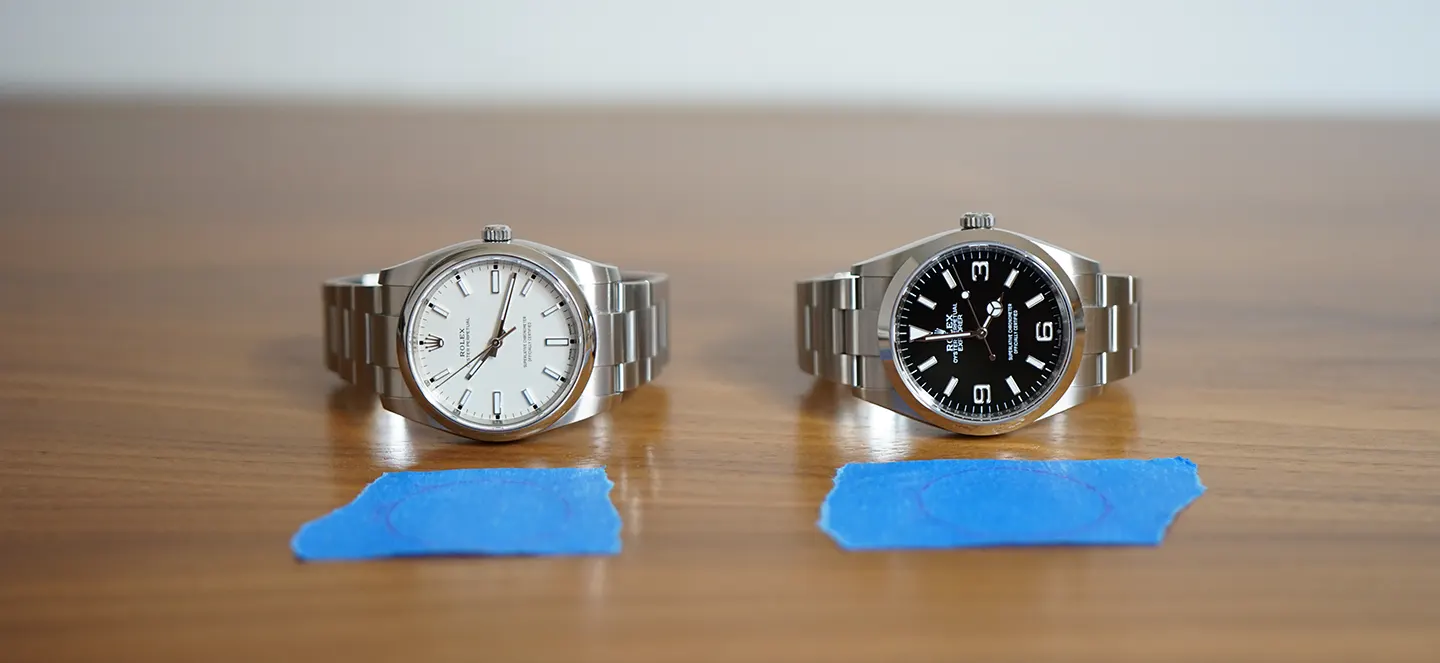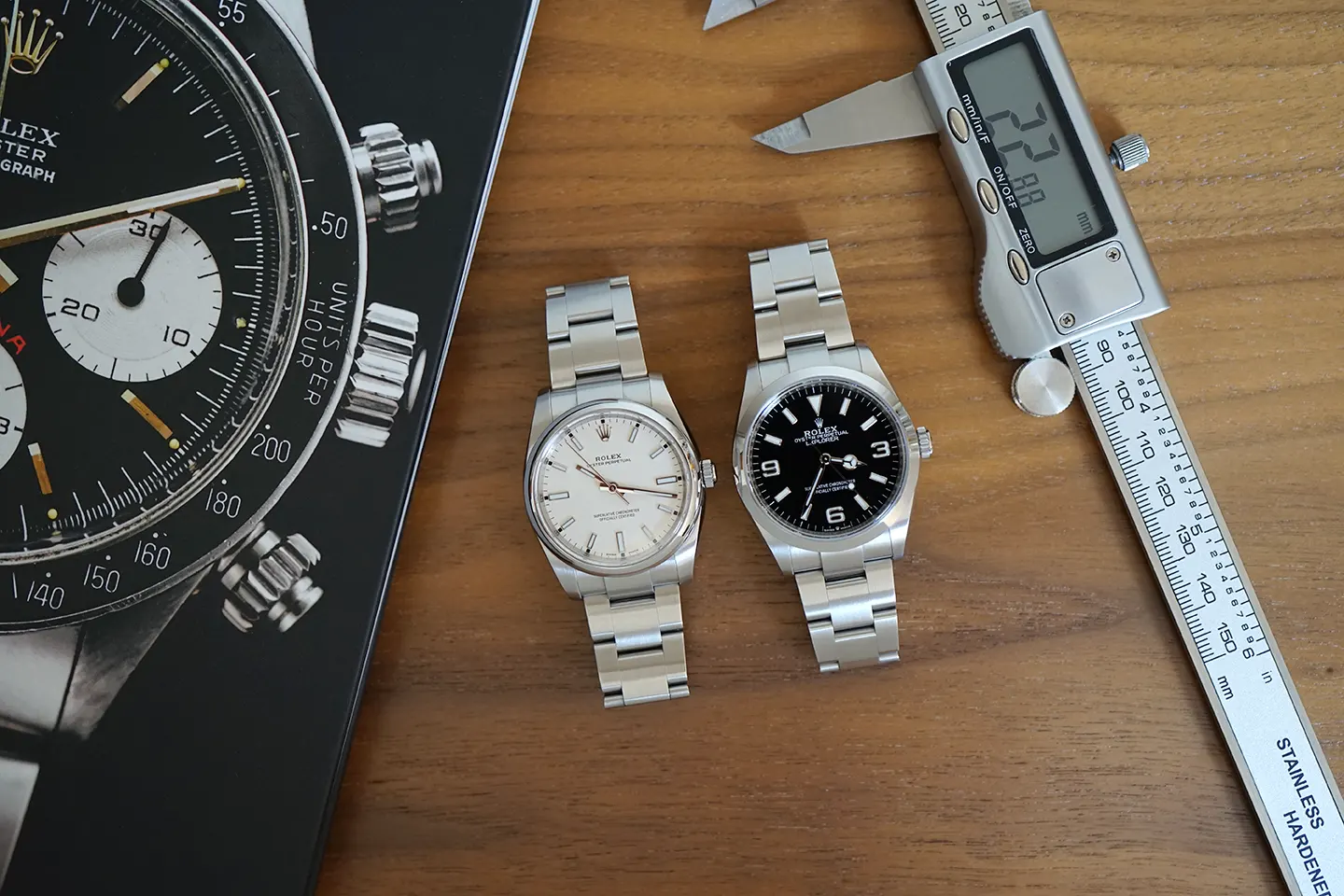Oyster 34mm vs Explorer 36mm: 114200, 124270
“A watch’s diameter doesn’t tell the full story.”
Recently Edward, a fellow watch enthusiast and seasoned collector, sparked an interesting conversation comparing the wearing experience of the white dial 34mm Rolex Oyster Perpetual 114200 and the 36mm Rolex Explorer 124270.
At first, comparing these two Rolex models might seem extraneous. However, both watches surprisingly wear similarly in hand, are unobtrusive, at comparaitive price points and hold go anywhere do anything (GADA) characteristics.
So, let’s dive into a hands-on comparison of these two Rolex classics, exploring what makes them similar yet unique, why you might prefer one over the other, and a weighting table that can help you decide.
.
Wear and Compare
At first glance, the clear conclusion is that the 34mm Oyster wears smaller than the 36mm Explorer and we should move on, but that’s not the case.
On paper, there are significant differences, however, both visually looks to be 36mm. There are a number of reasons:
Dial: White dials appear bigger, while dark dials appear smaller. The Oyster’s simpler baton indices create a feeling of space, while the Explorer’s Arabic numerals fill up the dial. The most critical attribute, the dial dimensions, are both unexpectedly 29mm.
Case: The case size of the Oyster is smaller, but due to its broader super case silhouette and thicker lugs, by design, evokes a strong presence. Additionally, the thinner bezel gives the Oyster dial more openness. In contrast, the Explorer achieves its balance with a slightly thicker bezel and curved lugs.
Bracelet: The larger case and tapered Explorer bracelet (19mm to 14mm) can also make the watch feel smaller. With my wrist size of 5.75”, I do not see a difference and the Oyster clasp proportions are just right. Larger wrists (6.75” plus) might find the bracelet undersized and want to try out other Explorer 36mm references.
On the wrist, the Oyster Perpetual feels true to its size at 34mm and is slightly more comfortable. Despite this, it still holds the same presence and visual sizing as the 36mm Rolex Explorer.
.
Differences to Consider
Outside of specs, here are the most important attributes I’d recommend looking at.
Comfort: Of all the watch brands I’ve tried, Rolex produces my favourite bracelets. “Velvety” is the word I would use to describe how the metal feels on the wrist. Both watches are a treat to put on. However, the Oyster retrofitted with an EasyLink wins out by a hair. As a side note, both bracelets are the most comfortable in my entire collection.
Cost: At MSRP and Grey Market, the Oyster Perpetual wins out. Though this reference had an unusually short run of only 2 years (making it rarer than the still-in-production Explorer 124270), however, at 34mm, it is often overlooked.
Versatility of Wear: With a water resistance of 100M and their low-key look, both watches can be worn anywhere. I’d argue that the Oyster Perpetual is the more versatile watch. It fits slightly better under the cuff and being more neutral, ties somewhat better on the gamut of formal, business casual and weekend wear. On the other hand, if you barely dress formally, I’d recommend the Explorer.
Availability: The Rolex Explorer is more readily available “for Rolex” and, from what I’ve read, has “reasonable” wait times through Authorized Dealers. I obtained mine (Dec 2021) after about 3 months of expressing interest. There are no white dial Oyster Perpetual references currently in production.
Partner: These watches are classic in design and proportions with universal appeal. If your partner has a similar wrist size, your significant other might be able to borrow your watch. In my case, my wife wears my Oyster over a sweater for the right fit.
.
Leather Straps
The topic of leather straps paired with these watches deserves special mention. Neither watch is optimized for leather straps.
Once removed, the same male end links that make the modern Oyster appear larger have the opposite effect. In addition, it just looks plain awkward. Just google “Rolex 114200 on a leather strap” or any modern variants and you’ll see the Internet agrees (with only one example).
The Explorer traditionally looks great on straps. However, the 124270 introduced recesses between the lugs and moved the spring bar holes closer to the case. Specialty straps with curved spring bars might still fit, but you’ll still see the indentation at certain angles.
The only strap configurations I recommend would be specialty integrated rubber straps or curved spring bars with NATOs. As an engineer, I’d also hack my strap clasp with a Rolex EasyLink.
Having said all that, both watches are best on a bracelet. I would so far as to recommend never putting either of these references on strap.

Dial and Crystal
The most critical attribute is the dial dimension; both are unexpectedly the same at 29mm in diameter.
Exact Measurments
Frottage imprints (using painter's tape and a pencil crayon) reveal both crystals measure 29mm.
.
If I Had to Pick
I compiled this weighted comparison table wondering which one would come out on top. The spreadsheet is also online to try yourself.
Weight and Points Score 10 (High) and 1 (Low)
If I had to pick only one, it’d be the Explorer, but only by a tiny margin.
.
Other Explorer References
Due to the popularity of the Explorer, you have some alternative options. With today’s (July 2024) economy, the older Explorer 14270 (released 1989-2001) can be had for as low as $4,200 and the Explorer 114270 (released 2001-2010) for $4,700, even cheaper than the Oyster Perpetual 114200 ($4,800).
There are slight differences, but both older references provide a modern “explorer” wearing experience at a better price point.
For those who like larger watches, there is also the 39mm 214270 (2010-2021).
.
Closing Thoughts
Both the Oyster Perpetual and the Explorer offer exceptional quality, versatility, and timeless design, embodying the renowned craftsmanship of Rolex.
As someone who owns both, I can attest that while the Explorer and the Oyster Perpetual are close in many ways, they are also distinctly different. Each can serve almost every situation, yet they don’t compete with each other in my collection.
The explorer wins by a hair, and I don’t intend ever to be letting go of either.
I hope you found the comparison useful. I’d love to hear your thoughts and experiences with these models. Please feel free to comment and share your perspectives!
.


